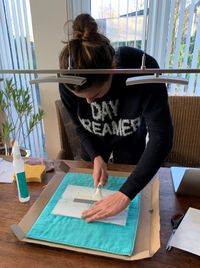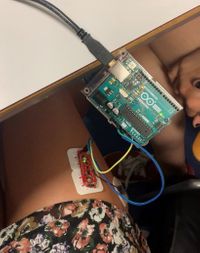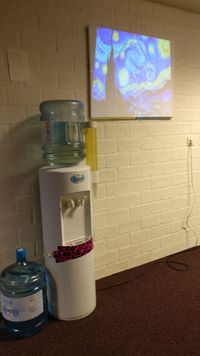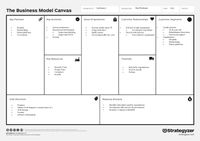Competence Areas
Creativity & Aesthetics
In Industrial Design you have to communicate your ideas through drawings in order to make them more understandable. In the first years, I had a lot of trouble with that. Gathering with groups, I would explain the ideas instead of showing them. I thought my drawings were not good enough and was afraid others would laugh about them. I took the course Exploratory Sketching for two reasons. The main reason was to improve my sketching and be able to communicate my ideas better to others. The other reason was to force myself showing people my work and be more confident about it. My goal is to be able to use my sketches in presentations and reports and feel like it is an addition to my stories. My drawing has improved and my sketches are good enough to communicate my ideas to others. However, I am not there yet where I want to be. I can reach my goal by practicing sketching every week multiple times and ask for feedback from another designer.
Another point I wanted to improve myself on was designing using InDesign and Illustrator. I would enjoy playing round with the programs, but never created something I could actually use in projects or elsewhere. This is why I did a side project and designed my own logo that I could use for my triathlon website. This way I could learn the skills while doing something not university related. I used the skills developed to design logos in my projects, but also to make small illustrations like the man and woman icons I used in my FBP.
To convince people to join in my ideas, I needed to improve the looks of the prototypes I was making. I noticed that I was struggling with this part in my previous FBP. This is why I decided to take the course Design & Sensorial Form. I learned here that the finish of a product can convince someone even if something else might be better but is looking slightly less good. Another thing I realized is how important good material choice is and what tools to use to develop good craftmanship. I was too late to implement this knowledge in my last FBP. However, even though I do not have a physical prototype in this FBP, I tried to use it by putting enough time in the looks of the prototype as well as the functioning of it.
Technology & Realization
During the first several projects, I would help my teammates with the realization of the physical prototypes. However, it was more like assisting them than doing things on my own. I never realized it during the projects until I was doing my previous FBP. I was struggling a lot and with the course Design & Sensorial Form I was finding my way back. I struggled during the whole course, it seemed like I could never meet the level of my fellow students. I wasn’t satisfied with the final objects I made and it also resulted in a retake. However, this retake was a chance to implement the new things learned about the realization and finish of prototypes as I was too late to implement it in my first FBP Kalliope. When I finished the assignments for the retake, I was way prouder of what I had achieved and I realized I was closer to the level of my classmates during the course.
My first experience with programming was during the first year in the courses Creative Programming and Creative Electronics. I found it quite hard and had to ask a lot of help from friends. A reason for this was that I missed the first weeks, because of the World Championships in triathlon. After passing the courses, I wasn’t satisfied with what I had learned so I decided to take an online HTML coding course on Codecademy. Thanks to this online course, I was able to enjoy playing around with code. When I followed Sensors for Physiology, I noticed that coding made a lot more sense and I could program more easily to make prototypes do what I wanted to. I also used that knowledge to realize the electronics part of my first FBP Kalliope.
However, during several courses where I needed coding language, I noticed that I just not seemed to understand the different terms and was mixing them up. I decided to retake the HTML code class of Codecademy to get the terms clearer to me. I still get confused by some terms, but generally I am aware what part is responsible for which part in the design.
For my FBP Cardionnect I needed way more code than I usually would use. This made the code very unclear. After some research, I realized I needed to make an extra file with CSS code. I remembered I used Codecademy for learning HTML language and thought I could use it again for gaining more knowledge about CSS. In the beginning I did not understand what I was doing and needed to redo some of the courses. However, after a while I understood the logic and knew how I could use it in my prototype.
User & Society
Ever since I can remember, I have been observing people. I was always wondering about what people thought and what beliefs made them do certain things. However, I did not have a lot of knowledge how I could use the observations of individuals to design something. That changed during my first project. I learned that you can use potential users in different ways. You can create a concept based on your user by doing user tests and interviews or you can create a concept and then search for a suitable user.
In order to learn more about users, I took the course Social-Cultural Sensitivity. It made me realize that culture has a big influence on how we perceive things and how we can look differently at the same things. Another course that helped me grow in the User & Society area is Human Factors. It showed to me the importance of having good user tests. It showed me that some design can be good from a design point of view. However, when looking at it from a human factors perspective the design can miss the point completely. This course taught me why user studies are a very important part of designing. I notice that in my daily life, I have more attention for the details of designs because of this course. Sometimes I see objects and get frustrated when I see that the users were not kept in mind while designing.
By doing user test over the years, you also learn about how to approach people in general. However, you learn how to approach individuals if you want to get certain specific information from them, e.g. in a user test. You learn to adjust beforehand, but also while testing you need to adapt yourself towards your user. No one is the same and sometimes you need to ask your questions differently or need more sub-questions to get to the information you want. It is a learning process and reflecting on the questions asked and answers received, I learned how to implement this knowledge into a next user test.
Business & Entrepreneurship
In the beginning, I would let team members take care of the business side of projects. They would explore different opportunities for our product or find ways to make our product or service profitable. I would help them with small side tasks and ask them in the end how they got to their conclusions and what everything meant. However, I did not know how to achieve the bigger picture of a business model and I knew this needed to change.
While doing the course Design Innovation Methods I learned about finding opportunities in already existing companies to expand their offer. Through the article “The innovator’s DNA” I realized that often the question that you ask is more important than the answer to that question. By asking a good question, you often find new insights about the topic that result in more questions and opportunities. To prove myself I was working on my skills in this expertise area, I volunteered to work on the business plan of our concept, implementing SmartGoals in the office environment.
More progression in Business & Entrepreneurship was made by taking the course Design Management. This course taught us to design for a company with keeping sustainability as most important criteria. Our group decided to design a system to show buyers how sustainable a HEMA product is. Not only did it show how sustainable the content of the product was, it also showed the sustainability of the production of it. Both Design Innovation Methods and Design Management taught me to look into opportunities in existing companies.
I implemented this knowledge in my FBP Cardionnect by looking at the bigger picture and writing down what I wanted to achieve with my design. But I also used it to find opportunities to provide the service to the users. For example, I wanted my product to reach as many cardiac rehabilitation patients as possible. A way for achieving that was finding good partners to provide my service with. In this way I am using existing channels to share my design through.
Math, Data & Computing
In my first year, I took the course Intelligent Products, not knowing that it was a more advanced course about machine learning. However, it taught me how learning algorithms could be used to develop designs and make the user experience more valuable. I did not use machine learning yet. However, I know it could be used in a further iteration of our design in Project 1. The LightMare device could learn about the nightmare patterns and act on this. It would also be a next step to integrate a learning algorithm in my FBP Cardionnect to make better buddy matches by learning from user feedback saying the match was good or not.
Furthermore, I have always been interested in people and how they use things. I always liked doing user tests. However, user tests come with a lot of data. I never liked data and analyzing it. I would always get lost in the amount of information I would get and what information was important for my projects. The courses Making Sense of Sensors and my second USE learning line course Data Acquisition gave me a lot of new insights how to deal with data. I learned about the different ways to analyze it and not make a mess out of it. In group projects I would do the analyzations together and we would experiment which analyzing method would work the best.
During my FBP Cardionnect I used cross-tabulation for my quantitative data. This way I could compare the overall results to different groups in order to see differences in answers. For the qualitative data I used open coding to group answers and to find the important parts of the interviews. Before this project I knew methods I could use for the analyzation, but had trouble implementing them. With some help in this project I got more information out of my data than I did in previous conducted user studies I did on my own. I also learned that you can better ask more information in user studies than finding out afterwards that you needed some more background information for example. I tried to prevent this by writing clearly down what the goals of the study were and getting the questions checked with someone. However, I also learned that I still forgot to ask important questions, e.g. if the participants would want to use Cardionnect.





